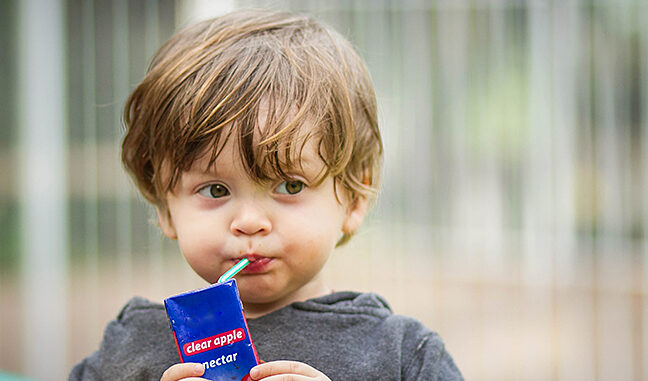
Parents are always gathering information to try to make the best decisions for their children’s health. It can be helpful for parents to have a greater understanding of what can put their child at risk for cavities and what can help prevent cavities. It is possible for many children to have a lifetime of “no-cavities” and in families that are highly prone to cavities, it is also possible to reduce the number and frequency of cavities.
Step One: Try to limit the amount of sugary and sticky foods kids eat. If possible, choose a sugar-free alternative, or limit the number of times kids have access to sugary and sticky foods.
There are different types of bacteria in everyone’s mouth, even in children and infants. Bacteria in saliva called Streptococcus mutans are primarily responsible for dental cavities. Like a lot of kids, cavity-causing bacteria are picky eaters, too. These bacteria have a preference for sugars and starch and break these down into acid. The acid wears away tooth enamel and leads to cavities or holes in the teeth. Foods that are sugary AND sticky pack a double-whammy. Not only do they allow the bacteria to produce acid, they also hang around for a while in the tooth grooves and give bacteria even more time to produce cavity-causing acid.
Gummy bears, figs, taffy, marshmallows and other sugary and sticky foods stay in contact with teeth a lot longer than foods that you quickly chew and swallow. These sticky types of foods have high “substantivity,” meaning they are persistent and they hang around on the teeth for a long time. Sugary and sticky snacks increase a child’s risk for dental cavities because bacteria can continue to feed on these foods and produce acid even after the food is consumed.
Step Two: Be aware of the cavity-causing potential of juice. Try to limit frequent sipping on juice.
Frequent snacking or sipping on fruit juices or sugary drinks can have the same effect. In this situation, bacteria that cause cavities are constantly being re-supplied with energy allowing them to produce more acid. The American Academy of Pediatrics has recommended children from one to six years of age consume no more than four to six ounces of fruit juice a day from a cup and as part of a meal or snack. Just for a size comparison, the typical “juice-box” geared towards kids contains about four to eight ounces of juice.
Step Three: Try to have parent-led brushing and flossing of kids’ teeth before bedtime and use the proper amount of toothpaste.
Bacteria in the mouth join together and form colonies or groups. The groups coalesce into sticky, fluffy, often white or yellow dental plaque. When you clean your child’s teeth, you are disrupting the plaque and brushing and flossing away a lot of the cavity-causing bacteria. Children often need help with this because they don’t usually have the dexterity or patience to spend the recommended two minutes in the morning and two minutes in the evening on oral health care. If your child is prone to dental cavities, the American Academy of Pediatric Dentistry recommends using a “smear” of fluoride-containing toothpaste for kids under age two years old and a “pea-sized” amount of fluoride-containing toothpaste for two- to five-year-old kids. Your child’s dentist can work with you to determine your child’s risk for cavities.
In 2009, the American Academy of Pediatric Dentistry changed their guidelines on infant oral care. Prior to this, parents were advised to use infant or “training” toothpaste on kids under two years old. Infant or “training” toothpastes do not contain fluoride and are geared towards kids who have not learned how to spit. While this seemed like a good idea originally, the downside is that children who use this type of non-fluoridated infant or “training” toothpaste do not receive the cavity-preventing benefits of fluoride. The current American Academy of Pediatric Dentistry recommendations are made with the intention of balancing the pros and cons of fluoride use in young kids. You can talk with your child’s dentist about which toothpaste is best for your child.
By understanding more about the process of tooth decay, you can decrease your child’s risk factors and help prevent cavities from starting. You can make just a few small, simple changes that can help your child maintain a healthy smile throughout their life!
-by Dr. Mandy Ashley & Dr. Madison Galloway
About the Authors: Dr. Mandy Ashley and Dr. Madison Galloway are Board Certified Pediatric Dentists proud to serve the communities of Bowling Green, Hopkinsville and GLASGOW! Our goal is excellent comprehensive dental care that is fun for children. We are thrilled to bring our modern, kid-friendly dental practice to the community of GLASGOW starting this month!
SKY Pediatric Dentistry has been providing care to children and adults with special needs since 2013. As board-certified specialists in dentistry for children, our team strives to make going to the dentist as fun as possible while maintaining high quality treatment and preventative measures. We tailor treatment plans to each child and offer a wide range of treatment options, including sedation and hospital-based dentistry. With over 25 YEARS of doctor experience, SKY Pediatric Dentistry is a great choice for children’s dental care in Bowling Green, Hopkinsville and now Glasgow!




